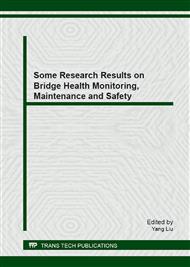p.79
p.87
p.99
p.107
p.119
p.131
p.141
p.153
p.165
Time-Dependent Shear Capability Analysis and its Application of Reinforced Concrete Simply-Supported Beam Bridge
Abstract:
The time-dependent parameters correction model related to shear capability of reinforced concrete (RC) component was analyzed and established on the basis of present time-varying model of resistance parameters of RC bridge. During the analysis, the time-variation of concrete strength, reinforced area, yield strength and cross-section geometric feature of reinforced concrete structure were considered in this paper. Also, the correction factor of comprehensive bearing capacity provided by both concrete and stirrup, the model comprehensive correction factor and the time-dependent comprehensive correction factor were introduced during the analysis. After calculating probability distribution and variation coefficient of parameters and correction factors mentioned above, through the Monte Carlo simulation method, the starting time of reinforcement corrosion, the reinforced effective area and the shear capacity were calculated time-dependently. Eventually a calculation example was presented in detail based on a real bridge engineering which proves the feasibility and applicability of the method mentioned in this article and can be referenced by other similar engineering.
Info:
Periodical:
Pages:
165-172
Citation:
Online since:
January 2013
Authors:
Price:
Сopyright:
© 2013 Trans Tech Publications Ltd. All Rights Reserved
Share:
Citation:


